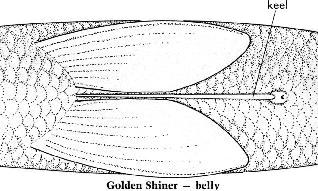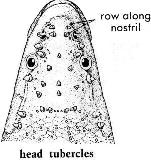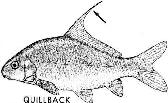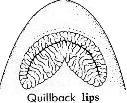
New Jersey freshwater fish identification
Carp, Chub, Fallfish, Stoneroller,
Dace and Suckers
Family Cyprinidae, Family Catostomidae
The Cyprinidae family consists mostly of minnows and is the largest family of fishes in the world including around
2100 species. These fish lack a normal set of teeth, but instead have 1 to 3 rows of teeth on the pharyngeal bone,
which grinds food against a prickly pad on the basioccipital bone. Some are carnivorous, but most feed mainly
on algae. Plant material takes much longer to digest making these fish have longer intestines. The inside lining of
the body cavity of carnivorous fish is usually white, that of omnivorous fish is black. Most minnows that live in
New Jersey will not be listed on this web page because there are so many and they are really just bait. Suckers
are from the Catostomidae family and have large thick lips used to "vacuum" invertebrates from stream and lake
beds. They all have 1 dorsal fin with 9 or more dorsal rays. There are 63 species of suckers in North America.

Grass carp (Ctenopharyngodon idella) grow as large as 49 inches, have a wide head and a terminal mouth. Their
scales are large and dark edged with a black spot at the base. They have a compressed body with the front of the
dorsal fin forward of the pelvic fin. The colors are gray to brassy-green above and white to yellow below with clear
to gray-brown fins. Grass carp are introduced to lakes and ponds in the U.S. to help control weed problems, but
sometimes take away from the food source of other animals such as waterfowl, creating another problem. The NJ
state record of 49 Lbs. 3 Oz. was taken with a bow and arrow by George Vash in the Delaware & Raritan Canal
in 1996. The hook and line record is vacant, but a catch must weigh at least 30 Lbs. to be considered.

Common carp (Cyprinus carpio) grow to about 48 inches and have 2 barbels that hang from each side of the
upper jaw. They have a deep, thick body with a very long dorsal fin. The young have a terminal mouth, meaning
it opens at the foremost part of the fishes head. They are gray (young) to brassy green (adult) above; white to
yellow below with black edged scales with a black spot at the base. The fins are dusky clear, but turn orange on
large adults. The NJ state archery record was taken by John Puchalik from the Delaware River in 1987 and
weighed 42 Lbs. 1 Oz. The NJ hook and line record was set by Billy Friedman in 1995 with a 47 pounder caught
in the South Branch of the Raritan
River. Here's ![]() a picture of that
record carp. Common carp stir up mud from
a picture of that
record carp. Common carp stir up mud from
the bottom of lakes and ponds causing them to be considered a nuisance. They readily hybridize with "pet store"
goldfish that are released into the wild.


Golden shiner (Notemigonus crysoleucas) get up to about 12 inches in length and have a scaleless keel along
the belly from the pelvic fin to the anal fin. They have a small upturned mouth and a pointed snout, and the dorsal
fin begins behind the origin of the pelvic fin. They are silver to gold in color, and are sometimes called a "roach".

Creek chub (Semotilus atromaculatus) grow to 12 inches, but are usually much smaller. They have a large black
spot at the front of the dorsal fin and on the caudal fin that is faded on large adults. They are olive-brown above
with green-silver sides and a dusky black stripe along its length. Breeding males have some orange on its fins and
blue and pink around the head. When ready to spawn, males dig a pit on the bottom of the stream using its mouth.
They then try to attract females over the pit, and when spawning occurs, the eggs fall in where the male will guard
them. Sometimes other fish will lay eggs in this pit, the creek chub will cover them up, move downstream and
start again.

Fallfish (Semotilus corporalis) can reach over 20 inches in length and have large scales, large eyes, and a long
round, slightly overhanging mouth. The dorsal fin starts over or only slightly behind where the pelvic fin starts. They
are olive to gold-brown above, bright silver on the sides, sometimes with a purple-blue sheen, and have a black bar
along the back of the gill cover.


Central stoneroller (Campostoma anomalum) grow to 8 1/2 inches, have a crescent-shaped row of 1 to 3
large tubercles on the inner edge of the nostrils and tubercles on the nape and on the body. They are olive-brown
with dusky mottling along the sides. Breeding males have a black band on orange dorsal and anal fins.


Blacknose dace (Rhinichthys atratulus) grow to about 4 inches, have a pointed snout with a barbel on each
side of the mouth. They are light brown above, silver-white below with many dark specks above, and a stripe along
the sides. Some have black and silver spots on the base of the dorsal fin.

Longose dace (Rhinichthys cataractae) grow to about 6 inches and have a long fleshy snout with barbels on the
side of the mouth. The eyes are high on the head and the caudal fin is forked. They are olive-brown to dark red-
purple above and silvery below with brown-black spots on the back and sides. Breeding males may have bright
red on the head and fins.


Quillback (Carpiodes cyprinus) is a suckerfish that grows to 26 inches and has a deep body with a small, cone-
like head. They have a very long first dorsal ray. They are Olive to gray on top and silvery on the sides with blue-
green reflections. The paired fins are white to orange; the other fins are dusky-gray.


White sucker (Catostomus commersoni) grow to about 25 inches, and have 0 to 3 rows of papillae on the
lower lip and 2 to 6 rows of papillae on the upper lip. They are olive-brow to black above and dusky below with
clear to dusky fins. Breeding males are goldish on top with a scarlet, cream or black stripe along the sides.


Longnose sucker (Catostomus catostomus) reach about 25 inches in length and have a long snout. They are
dark olive or gray above and white or cream below with a brassy reflection and dark gray irregular blotch marks.
The breeding male is nearly black, large females may be green-gold to copper-brown fading to white, orange or
pink. They have a red stripe along the sides. Some species of Longnose suckers are dwarfed.

Creek chubsucker (Erimyzon oblongus) grow to about 8 inches and have a chubby body and a small mouth. The
dorsal fin edge is rounded and the caudal peduncle is rounded. They are olive to brown above and white to yellow
below with dark edged scales and yellow-orange to olive-gray fins. Young have a broad yellow stripe along the top
and breeding males have some pink-yellow with orange paired fins.


Northern hog sucker (Hypentelium nigricans) grow to about 24 inches and have a large rectangular head that is
flat or even concave between the eyes. The body is wide in front of, and tapering behind the dorsal fin. They have
large fanlike pectoral fins. They are dark olive or bronze to red-brown above and pale yellow or white below
with light stripes along the sides, a blue-black snout and olive to light orange fins. Large fish have a black-tipped
dorsal fin usually with 11 dorsal rays.
The New Jersey bag limit on carp and suckers is 25 fish with no minimum length.
questions about fish terminology? GO TO: FISH BODY CHARTS
GO TO NJ FRESHWATER FISH ID MAIN PAGE
GO TO NJ COMMON FRESHWATER FISH PAGE
GO TO NJ UNCOMMON FRESHWATER FISH PAGE
By Joe M. Cianci. See main page for list of sources. Send E mail to me at joecianci@comcast.net Comments welcome!
HITS ON
THIS PAGE
04/29/99